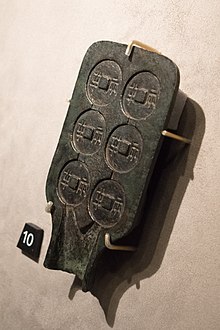
Back Banliang Catalan 半両銭 Japanese 반량전 Korean Ban Liang Dutch Banliang NB Ban Liang SIMPLE Bán lạng Vietnamese 半两 Chinese 半兩錢 ZH-YUE

The Ban Liang (Traditional Chinese: 半兩 ; Pinyin: bàn liǎng) was the first unified currency of the Chinese empire, first minted as early as 378 BCE and introduced by the first emperor Qin Shi Huang as China's first unified currency around 210 BC[1] (although coins with this inscription already circulated in the State of Qin prior to unification). It was round with a square hole in the middle. Before that date, a variety of coins were used in China, usually in the form of blades (knife money, spade money) or other implements, though round coins with square holes were used by the State of Zhou before it was extinguished by Qin in 249 BCE.[2]
The Ban Liang corresponds to a "half tael" (半兩), or twelve zhu (銖, about 0.68 grams). It typically weighs between ten and six grams, roughly corresponding to the Greek stater.
The standardization of currency with this round coinage was part of a broader plan to unify weights and measures during the Qin empire.[3][4] Ban Liang coins continued to be used under the Western Han dynasty until they were finally replaced by the Wu Zhu cash coins in 118 BC.
- ^ "China: Ancient Tomb of First Emperor Qin Shi Huang's Grandmother Discovered in Xi'an". Mary-Ann Russon (International Business Times – United Kingdom). 11 September 2014. Retrieved 16 June 2017.
- ^ Travel China Guide Qin & Han Money - Ban Liang Qian & Wu Zhu Qian. Retrieved: 14 June 2017.
- ^ "Chinese coins – 中國錢幣". Gary Ashkenazy / גארי אשכנזי (Primaltrek – a journey through Chinese culture). 16 November 2016. Retrieved 14 June 2017.
- ^ Maine University Warring States Period 战国 Ban Liang Coins 半两钱 货币。 Archived 2017-10-25 at the Wayback Machine March 2010. Retrieved: 14 June 2017.